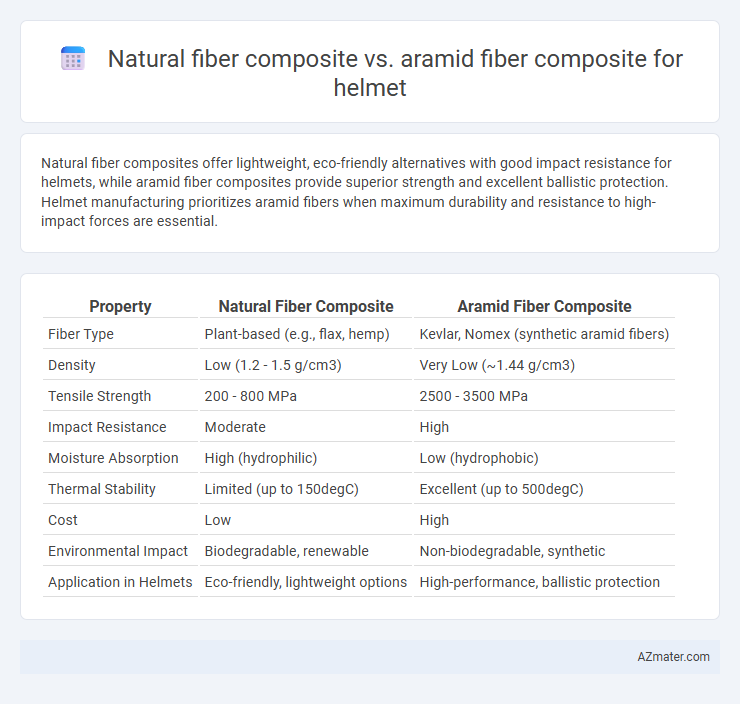Natural fiber composites offer lightweight, eco-friendly alternatives with good impact resistance for helmets, while aramid fiber composites provide superior strength and excellent ballistic protection. Helmet manufacturing prioritizes aramid fibers when maximum durability and resistance to high-impact forces are essential.
Table of Comparison
| Property | Natural Fiber Composite | Aramid Fiber Composite |
|---|---|---|
| Fiber Type | Plant-based (e.g., flax, hemp) | Kevlar, Nomex (synthetic aramid fibers) |
| Density | Low (1.2 - 1.5 g/cm3) | Very Low (~1.44 g/cm3) |
| Tensile Strength | 200 - 800 MPa | 2500 - 3500 MPa |
| Impact Resistance | Moderate | High |
| Moisture Absorption | High (hydrophilic) | Low (hydrophobic) |
| Thermal Stability | Limited (up to 150degC) | Excellent (up to 500degC) |
| Cost | Low | High |
| Environmental Impact | Biodegradable, renewable | Non-biodegradable, synthetic |
| Application in Helmets | Eco-friendly, lightweight options | High-performance, ballistic protection |
Introduction to Helmet Composite Materials
Natural fiber composites in helmets offer eco-friendly advantages, combining cellulose-rich fibers like flax or hemp with polymer matrices to reduce weight while maintaining impact resistance. Aramid fiber composites, such as those using Kevlar, provide exceptional tensile strength and energy absorption crucial for high-performance helmets in military and sports applications. Both materials enhance helmet safety, but aramid composites excel in durability and ballistic protection, whereas natural fiber composites prioritize sustainability and lightweight design.
Overview of Natural Fiber Composites
Natural fiber composites, composed of fibers such as flax, hemp, and jute embedded in polymer matrices, offer a sustainable and lightweight alternative for helmet manufacturing. These composites provide enhanced impact absorption and vibration damping due to the inherent flexibility and toughness of natural fibers, contributing to improved comfort and safety. Although natural fibers exhibit lower tensile strength and moisture resistance compared to synthetic fibers like aramid, advancements in fiber treatment and hybridization techniques are progressively enhancing their performance for protective gear applications.
Overview of Aramid Fiber Composites
Aramid fiber composites, commonly used in helmets, offer exceptional impact resistance and high tensile strength, making them ideal for protective headgear. These composites provide superior energy absorption and durability compared to natural fiber composites, which are generally lighter but less impact-resistant. Aramid fibers, such as Kevlar, are preferred in safety applications due to their heat resistance, low weight, and reliable performance under extreme conditions.
Mechanical Properties Comparison
Natural fiber composites exhibit lower tensile strength and impact resistance compared to aramid fiber composites, making them less suitable for high-performance helmet applications requiring superior mechanical protection. Aramid fibers, such as Kevlar, provide exceptional energy absorption, high stiffness, and outstanding tensile strength, enhancing helmet durability and safety under extreme impact conditions. While natural fibers offer advantages in sustainability and weight reduction, aramid composites remain the preferred choice for helmets demanding superior mechanical properties and impact resistance.
Impact Resistance and Energy Absorption
Natural fiber composites exhibit high energy absorption due to their superior damping properties, making them ideal for impact resistance in helmet applications. Aramid fiber composites, such as Kevlar, offer exceptional tensile strength and superior impact resistance by effectively distributing collision forces, enhancing helmet durability. While natural fibers provide eco-friendly alternatives with effective energy dissipation, aramid composites deliver unmatched impact protection and lightweight performance crucial for advanced helmet safety.
Weight and Comfort Considerations
Natural fiber composites offer significantly lower weight compared to aramid fiber composites, enhancing helmet comfort by reducing strain on the wearer's neck during prolonged use. Their excellent breathability and moisture-wicking properties contribute to improved thermal regulation and overall comfort. However, aramid fiber composites provide superior impact resistance and durability, making them ideal for high-performance helmets despite being heavier.
Environmental Sustainability and Biodegradability
Natural fiber composites, derived from renewable sources like flax, hemp, and jute, offer significant advantages in environmental sustainability due to their lower carbon footprint, reduced energy consumption during production, and inherent biodegradability. Aramid fiber composites, while providing superior impact resistance and durability for helmets, are synthetic, energy-intensive to produce, and pose challenges in end-of-life disposal due to their non-biodegradable nature and limited recycling options. Choosing natural fiber composites enhances helmet sustainability by minimizing environmental impact and supporting circular economy principles through biodegradability and eco-friendly raw materials.
Cost and Manufacturing Process
Natural fiber composites offer a cost-effective alternative for helmet production due to the low price and renewable availability of fibers like jute or hemp, combined with straightforward manufacturing methods such as compression molding. Aramid fiber composites, like Kevlar, incur higher costs driven by expensive raw materials and complex fabrication processes including resin transfer molding and autoclaving to achieve superior impact resistance. The manufacturing of natural fiber composites tends to be more environmentally sustainable and energy-efficient, whereas aramid composites demand advanced technology and skilled labor, impacting overall production expenses.
Safety Standards and Testing Results
Natural fiber composites in helmets offer eco-friendly alternatives with moderate impact resistance, meeting basic safety standards such as DOT and EN 1078 but often falling short in advanced ballistic testing. Aramid fiber composites, known for their high tensile strength and energy absorption, consistently achieve superior performance in rigorous tests including SHARP and Snell certifications, providing enhanced protection against high-velocity impacts. Testing results indicate aramid composites deliver better durability and deformation resistance, making them the preferred choice in applications requiring maximum safety compliance.
Future Trends in Helmet Composite Materials
Natural fiber composites for helmets are gaining attention due to their sustainability, biodegradability, and lightweight properties, which align with growing environmental regulations and consumer demand for eco-friendly protective gear. Aramid fiber composites continue to dominate the market with superior impact resistance, durability, and high tensile strength, making them essential for advanced ballistic and high-performance helmet applications. Future trends indicate a hybrid approach combining natural fibers with aramid reinforcements to optimize mechanical performance, reduce carbon footprint, and enhance helmet comfort and safety.

Infographic: Natural fiber composite vs Aramid fiber composite for Helmet
 azmater.com
azmater.com